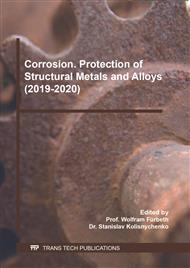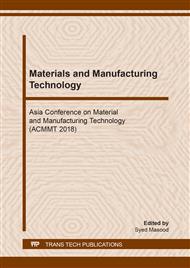p.3
p.9
p.15
p.21
p.29
p.37
p.43
p.49
Effect of Micro-Zone pH Gradient on AM60B Vanadate Film and Corrosion Behavior
Abstract:
To further study the formation and corrosion mechanisms of AM60B vanadate films, a vanadate coating was synthesized on AM60B substrate via a chemical conversion at 50°C. The morphologies of the films and the corrosion samples were observed by using scanning electron microscopy(SEM), energy dispersive X-ray analysis(EDAX) was used to analyze the elemental distribution of the film surface and the Electrochemical Impedance Spectroscopy(EIS) and the polarization curves of the films were tested by an electrochemical workstation. The morphology of conversion film is layered structure with white balls. V element preferentially deposits near the base end and the V-rich phase is easily generated on the β-phase(Mg17Al12). In the course of corrosion, corrosion begins near the α-phase(Mg). During the processes of observation and analysis, the concept of micro-zone pH gradients was discovered and applied, and attempts were made to explain some observed phenomena by using this concept. The results show that the concept of pH gradients in micro zones can be used to explain the film formation and corrosion mechanisms well.
Info:
Periodical:
Pages:
21-27
Citation:
Online since:
August 2019
Authors:
Keywords:
Price:
Сopyright:
© 2019 Trans Tech Publications Ltd. All Rights Reserved
Share:
Citation:



